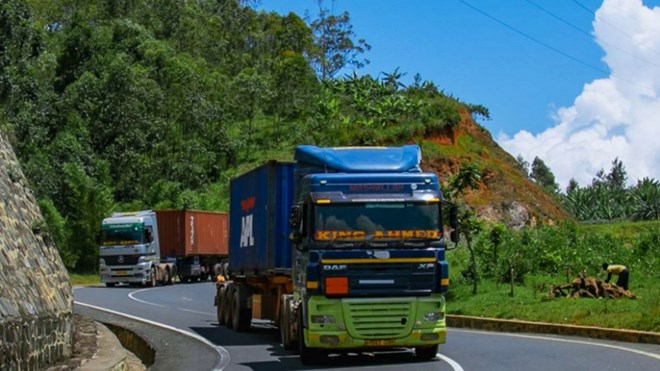The New Times
Thursday July 9, 2020
By Julius Bizimungu

Cross border cargo trucks from Tanzania to Rwanda.According to the report Rwanda’s economic growth, like the rest of the region, is expected to decelerate in 2020. / Sam Ngendahimana
Rwanda’s economic growth, like the rest of the region, is expected to decelerate in 2020 before picking up slightly in 2021, according to the latest outlook of the African Development Bank released Wednesday.
The outlook indicates that the novel Coronavirus pandemic will exacerbate pressure on Rwanda’s economy, growing at only 4.2 per cent in 2020, revised down from the 8 per cent previous projection.
Only Rwanda and Tanzania are projected to record growth rates above 4 per cent in 2020.
In the worst scenario, Rwanda’s economy will grow at only 2.9 per cent.
The country’s external debt stands at 42.3 per cent of GDP and domestic debt is only 6.8 per cent, and the country is ranked among the moderate risk debt distress countries.
Djibouti and South Sudan were projected to join the high growth countries in 2020, according to the report which covers 13 countries, including Rwanda, Kenya, Uganda, Ethiopia, Eritrea, Comoros, Tanzania, Djibouti, Somalia, South Sudan, Burundi,
However, with the Covid-19 pandemic, only Rwanda and Tanzania are projected to record growth rates above 4 per cent in 2020.
Regional picture
East Africa’s economic growth was projected to be 5.1 per cent in 2020, remaining the fastest growing region in Africa, according to the latest forecast from the AfDB economists.
All countries in the region were projected to positively contribute to the growth, except for Sudan whose economy was projected to slow by 1.6 per cent in 2020 due to the political conflict in the country.
The region’s growth is largely driven by strong public spending in infrastructure, rising domestic demand, the benefit of improved stability, new investment opportunities and incentives for industrial development.
However, with the Covid-19 related disruptions of fiscal expenditure plans, revenue mobilization, supply chains and international market demands, the region’s growth will be dampened significantly.
The region’s 2020 growth is projected at 1.2 percent in the baseline scenario and 0.2 percent in the worst-case scenario.
A recovery of 3.7 percent in the baseline scenario and 2.8 percent in the worst-case scenario is however projected in 2021 under the assumption that Covid-19 would be contained in the short-to-medium term.
“No economy has been spared by the Covid-19 pandemic. Whether developed, emerging and developing economies, all are at risk and our East African region is not an exception,” Nnenna Nwabufo, Country Manager for East Africa Regional Development noted.
The risk of debt distress has increased in Ethiopia, Eritrea, Kenya, South Sudan and Sudan.
The region’s current account deficit was projected to slightly deteriorated to 6 per cent of GDP in 2020 from 5.9 per cent in 2019, this has also been revised in the wake of Covid-19 to 7.0 per cent of GDP.
The impact of the region’s economic growth on poverty, inequality and unemployment is expected to remain minimal, with inequality, poverty and unemployment expected to persist in 2020.
The growth in the region will, however, surpass the average for Africa of -1.7 per cent in 2020.
That shows resilience for the East African region, according to Mercellin Ndong Ntah, the lead economist at the Bank’s East African Regional Department.
“All other regions (in Africa) are in recession, which means they will record negative growth, except East Africa,” he noted.
Real GDP growth rates for five East African countries (Ethiopia, Kenya, Rwanda, Tanzania and Uganda) are projected to exceed the regional average in 2020 compared to seven countries prior to the pandemic.
The impact
The pandemic will likely be transmitted to the region through reduced commodity prices and trade, foreign direct investments, tourism and travel, volatility in financial markets, and disruptions in the education and health sectors.
The impact on commodity prices, tourism and financial markets is largely expected to be short-term while lasting effects are envisaged for foreign direct investments, education and health, according to AfDB.
Most East African countries are net commodity exporters with heavy reliance on markets in Asia, notably China.
For instance, China accounted for over 90 per cent of South Sudan’s oil exports and over 50 per cent of Eritrea’s market for zinc and copper ore.
Economic slowdown in China will reduce East Africa’s public revenues and foreign exchange inflows and weaken the trade balances. However, net importers will benefit from lower commodity prices.
Asia is also a source of inputs for the region’s budding industrial sector, but global supply chains have been disrupted, adversely affecting East Africa’s industry and services sectors.
Africa needs an immediate emergency economic stimulus to the tune of $100 billion to respond to the Covid-19 crisis.
Recovery
The International Monetary Fund (IMF) and the World Bank have already approved funding in response to Covid-19 for Rwanda amounting to $123.65 million.
The report suggests that economic recovery will require the region to consolidate peace and stability, accelerate structural transformation, strengthen macroeconomic policy coordination, and diversify the development financing sources.
Ndong Ntah highlighted that to achieve structural transformation, countries should move from low to higher value addition productivity that will allow them to mitigate the vulnerabilities.
Deepening regional integration and developing skills for the workforce of the future is also seen as a key driver for recovery.
This is in addition to facilitating private sector activity to return to their growth trajectory, enabling job creation and poverty reduction.